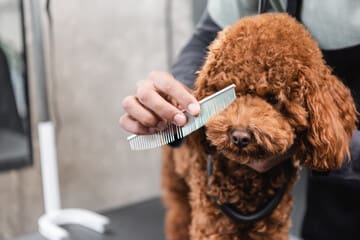
To brush or not to brush, THAT is the question!

Different coat types
If you have a furnished Doodle, Poodle, or any other dog that is low or non-shedding, chances are that a previous groomer has recommended that you brush your dog at home. Brushing is the main way to prevent hair in the coat from knotting together and forming mats. These breeds naturally hold onto dead hair and debris (i.e. dirt, burrs, twigs and sand) … and you know what happens when too long of time goes by in-between appointments; pesky de-matting fees or even the ever-feared shave.
If you have a double-coated breed or unfurnished Doodle, without brushing its dead hair will release and end up all over the floors of your home and your clothes. Sometimes these breeds can also develop matting, although its usually superficial and easier for a professional to remove than you think.
Wire-haired breeds and Doodles have a unique coat that generally mats the least. We always recommend “stripping” these coats to preserve the dog’s natural texture and color. Click here for details on how to hand strip at home.
So, does your dog need brushing in between grooms? The easiest answer is NO.
Put the brush DOWN
What?! Why?! We just explained that all dogs require brushing!
YES, all dogs require brushing. If you are a member of CD Society, we will give you a bespoke haircut that is tailored to the length of time you prefer in between grooming services. Our staff will ensure that in most cases, you do not need to brush at home to maintain the look you desire. That’s our job. If you like your dog as long as possible, you may still need to brush based on your dog’s lifestyle to prevent mats.
Pick the brush UP
Brushing your dog at home is still an excellent way to desensitize your dog to handling its paws, legs, tail, and face (the areas more sensitive to brushing) in preparation for a lifetime of grooming. It’s also a nice way to strengthen the bond between you and your pet. Brushing your dog with love and compassion is what we do here. Brushing at home it will help reduce anxiety during the grooming process. Here are a few quick tips to ease anxiety while brushing at home:
- Using a slicker brush, the best way is to start is at the paws and work your way up, always brushing in the direction of the way the coat grows. It’s much less stress on your dog to brush into an already brushed coat. If your dog’s coat is crunchy or dirty, add cornstarch to each section and brush it through until you don’t feel friction.
- Be mindful of how much time you are spending on a concentrated area. Repetitive strokes in one place may damage the skin. Travel around each section of the dog, brushing in “lines” so you can see the progress as you work.
- If your dog is biting you for brushing, that means they are asking you to stop. They are asking you to stop because they are either in fear or pain. Take a second to think about the reasoning. Have you hit a mat? Are you holding your dog in a restrictive or unnatural position? Not reacting emotionally to your dog for showing adversity towards brushing helps establish trust. Instead, remain calm and encourage them with intention rather than words. A quick break while you pet them or asking for a kiss may help calm them as well, as it takes their mind off of the brush.
- Positively reinforce calm behavior while brushing by rewarding with treats or praise. Careful giving too much “high-pitched” praise, as this can make them excitable.
- If your dog is super wiggly, trying raising their elevation to a safe but comfortable level. Placing your dog on an ottoman or washing machine might be enough incentive to keep them still. This is also a good way to have a better visual of the coat and what you are working with.
- NEVER attempt to cut mats out of your dog with scissors, especially behind the ears where mats naturally occur from the abundance of movement and petting in that area.
- Finish by combing with a medium/coarse comb. Combing is essential to guarantee that you have successfully brushed through the clumps of hair and mats. If your dog is resistant to the comb, this almost always means that you need to go back and be more thorough with the slicker brush. If your dog is still intolerant, call us for further consult and we will be happy to talk you through the process.


